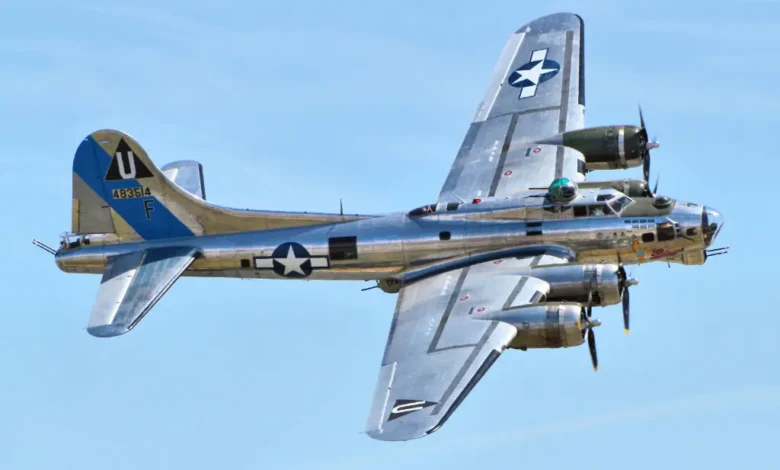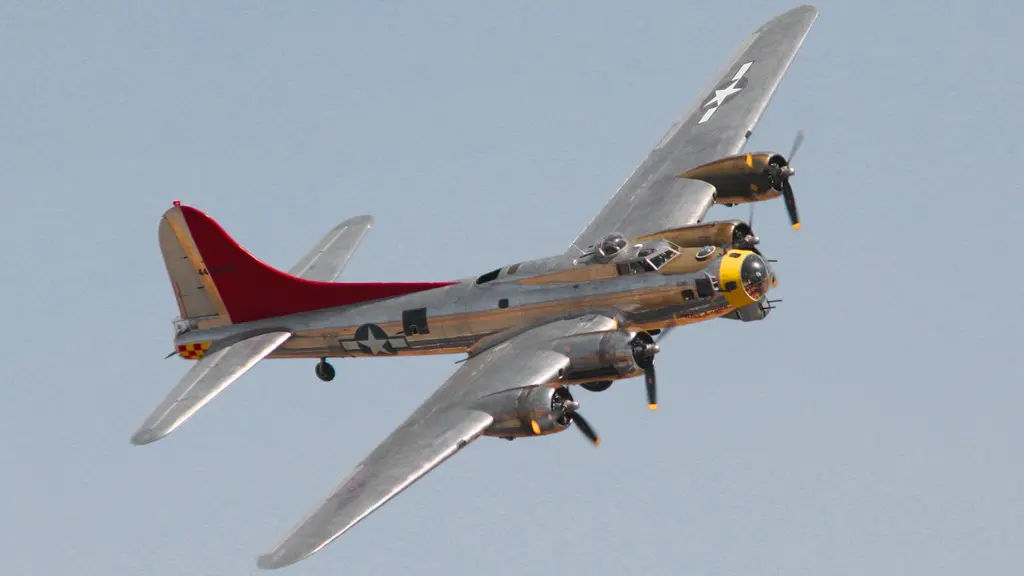Boeing B-17 Flying Fortress

The Boeing B-17 Flying Fortress is an iconic American four-engine heavy bomber introduced in the 1930s and heavily used by the U.S. Army Air Forces during World War II. Famous for its ruggedness, survivability, and ability to return home despite severe damage, the B-17 played a crucial role in daylight precision bombing over Europe. More than 12,700 B-17s were produced, making it one of the most recognized bombers in history.
Fact Sheet
| Role | Heavy Bomber |
|---|---|
| Manufacturer | Boeing (also Douglas & Vega under license) |
| First Flight | July 28, 1935 |
| Service Entry | 1938 |
| Crew | 10 |
| Number Built | 12,731 |
Specifications (B-17G Model)
| Length | 74 ft 4 in (22.66 m) |
|---|---|
| Wingspan | 103 ft 9 in (31.62 m) |
| Height | 19 ft 1 in (5.82 m) |
| Wing Area | 1,420 sq ft (131.92 m²) |
| Empty Weight | 36,135 lb (16,391 kg) |
| Loaded Weight | 54,000 lb (24,500 kg) |
| Max Takeoff Weight | ~65,500 lb (29,700 kg) |
| Powerplant | 4 × Wright R-1820-97 Cyclone radial engines (1,200 hp each) |
| Max Speed | 287–295 mph (462–475 km/h) |
| Cruise Speed | 182–193 mph (293–310 km/h) |
| Range | 2,000 mi (3,220 km) with 6,000 lb bomb load |
| Service Ceiling | 35,000 ft (10,670 m) |
| Rate of Climb | 900 ft/min (4.57 m/s) |
Armament & Defensive Equipment
| Guns | Up to 13 × .50 in (12.7 mm) M2 Browning machine guns (various positions) |
|---|---|
| Bomb Load | Up to 8,000 lb (3,600 kg) typical, maximum up to 17,196 lb (7,800 kg) for short-range missions |
| Aiming Equipment | Norden bombsight for precision targeting |
Notable Features
- Extensive defensive armament giving the “Flying Fortress” reputation
- Renowned for durability and ability to fly home with severe battle damage
- Famed for strategic daylight bombing in WWII European Theater
- Robust, reliable airframe with four powerful engines
- Often featured in postwar search-and-rescue and civilian roles

The Boeing B-17 Flying Fortress is one of the most iconic and recognizable aircraft of World War II. It was an American four-engine heavy bomber developed in the 1930s for the United States Army Air Corps (USAAC). Its name, “Flying Fortress,” was famously coined by a Seattle Times reporter who marveled at the prototype’s defensive armament.
Development and Purpose
The B-17’s origins trace back to an August 1934 USAAC proposal for a multi-engine bomber to replace the Martin B-10. The Air Corps sought a long-range bomber capable of reinforcing air forces in Hawaii, Panama, and Alaska, with requirements for a substantial bombload, high altitude, and decent speed.
Boeing’s “Model 299” prototype, designed by a team led by E. Gifford Emery and Edward Curtis Wells, first flew on July 28, 1935. Its four engines and impressive performance surpassed competitors from Douglas and Martin. Despite an early crash during testing (attributed to a forgotten gust lock, leading to the adoption of modern pilot checklists), the USAAC was impressed, leading to initial orders.
The B-17 was primarily developed as a daylight strategic bomber. The doctrine of the U.S. Army Air Forces (USAAF) heavily relied on the idea that tightly packed formations of heavily armed B-17s could defend themselves against enemy fighters without the need for escort, relying on their sheer defensive firepower. This belief, however, proved costly in the early stages of the European air war until long-range fighter escorts like the P-51 Mustang became available.
Key Features and Capabilities (B-17G, the definitive variant)
The B-17 underwent numerous improvements throughout its production run, with the B-17G becoming the most numerous and definitive variant.
- Four Engines: Powered by four Wright R-1820-97 “Cyclone” radial engines, each providing around 1,200 horsepower. This gave it good speed (max 287 mph at 25,000 feet) and the ability to absorb damage and often return home even with one or more engines out.
- Heavy Defensive Armament: This was the hallmark of the “Flying Fortress.” The B-17G typically featured 13 x .50 caliber (12.7 mm) M2 Browning machine guns positioned in various turrets and mounts to provide formidable overlapping fields of fire:
- Chin turret (powered)
- Top (dorsal) turret (powered)
- Ball turret (powered, ventral)
- Tail turret (powered)
- Two waist guns (manual)
- Two cheek guns (manual, in the nose)
- Bomb Load: Could carry a “useful bombload,” typically around 4,000-6,000 lbs (1,800-2,700 kg) for long-range missions, or up to 17,600 lbs (8,000 kg) for short-range missions.
- High Altitude Capability: Capable of operating at altitudes above 25,000 feet (7,600 m), which made it challenging for early enemy fighters to intercept effectively and provided some protection from ground-based anti-aircraft fire.
- Ruggedness and Survivability: The B-17 earned a legendary reputation for its ability to withstand immense battle damage and still bring its crew home. Its robust construction and distributed systems often allowed it to absorb hits that would cripple other aircraft.
- Crew: A typical crew consisted of 10 airmen: Pilot, Co-Pilot, Navigator, Bombardier, Radio Operator, Flight Engineer/Top Turret Gunner, Ball Turret Gunner, two Waist Gunners, and Tail Gunner.
- Norden Bombsight: Equipped with the top-secret Norden bombsight, which promised high accuracy for daylight precision bombing, though actual combat results often varied due to factors like weather, evasive maneuvers, and enemy defenses.
Production and Service
- Total Production: Between 1935 and May 1945, 12,731 B-17s were produced by Boeing, Douglas, and Lockheed (through its Vega subsidiary).
- Primary Use: The B-17 was the backbone of the daylight strategic bombing campaign conducted by the U.S. Army Air Forces (especially the Eighth and Fifteenth Air Forces) in the European Theater of Operations (ETO). Its missions targeted German industrial centers, military installations, and infrastructure. It also saw service in the Pacific, though to a lesser extent, where its performance wasn’t as critical as in Europe.
- Losses: Of the total produced, approximately 4,735 B-17s were lost during combat missions in World War II, a testament to the ferocity of the air war.
- Post-War Use: After WWII, most combat-weary B-17s were scrapped. However, some found continued use in various roles, including:
- Transport and reconnaissance
- Air-sea rescue (as DB-17s, equipped to drop lifeboats)
- Drone controllers (especially in the 1950s for missile tests)
- Firefighting (as air tankers, with some serving into the mid-1980s)
Retirement and Legacy
The B-17 was rapidly rendered obsolete by the advent of jet aircraft and more advanced piston-engine bombers like the B-29 Superfortress by the end of WWII. The last B-17 to serve with the U.S. Air Force, B-17G #44-83684, was officially retired on August 6, 1959, after serving as a drone controller. Some B-17s continued in civilian roles (like firefighting) until the mid-1980s.
Today, fewer than 100 B-17 airframes exist, with less than 15 still in airworthy condition. These surviving aircraft are cherished museum pieces and airshow performers, serving as powerful reminders of the valor and sacrifice of the aircrews who flew them during World War II.
The B-17 Flying Fortress remains a symbol of American resolve and industrial might during WWII, revered for its resilience and the critical role it played in the Allied victory.



